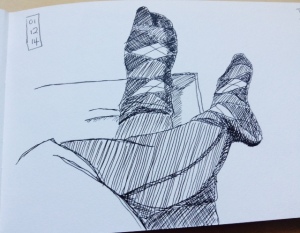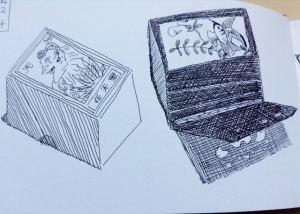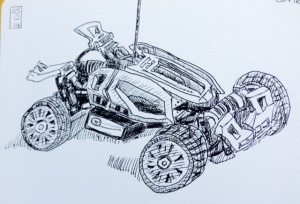Trust in Nature
Posted: December 3, 2018 Filed under: Art, artist, Creativity, painting | Tags: animal portraits, art, artist, creativity, draw, drawing, drawing sheep, ecotherapy, Grow Project, illustration, mental health, National Trust, painting, Saddlescombe Farm, sheep, TIN, Trust in Nature, wellbeing Leave a comment
I’m not posting a face today. I volunteer from time to time at the National Trust’s Saddlescombe Farm in East Sussex for a project called Trust in Nature & when I was there today I was “volunteered” to decorate a large green box which holds all the wellbeing resources. My favourite thing about the farm is the sheep so I started by painting a sheep on the box, and then a feather I found on a shelf nearby. It was the perfect way to spend a day, painting by the fire, while others collected natural materials and decorated the Christmas tree behind me.
Trust in Nature grew out of the wonderful Grow Project, an ecotherapy project also based at Saddlescombe Farm for people who have experienced mental health difficulties and feel they would benefit from time in nature. I did a Grow season in the spring of 2017 and it helped me cope so much better with both my mental health and pain problems.

Trust in Nature, or TIN, is a volunteering project open to anyone who has done the Grow Project. Project tasks can range from scrub clearing to gardening to printmaking. Since I have impaired mobility I can’t do many of the more active tasks so I don’t volunteer as regularly as some, but I try to go as often as I can, especially if there are creative tasks I can contribute to. And I can’t think of a better way to spend a day there than painting sheep! I haven’t finished the box yet; I’ll try to finish it next week. If I do I’ll post a photo here.
If you’d like to know more about the Grow Project click here. I can’t recommend it enough if you need some headspace and healing space and/or if you have funds and are looking for a project to support financially.
To learn more about the Saddlescombe Farm and estate click here.
Carrie/Leia
Posted: December 28, 2016 Filed under: Art, artist, Creativity, digital drawing, Drawing, illustration, Portraits, Sketching, Uncategorized | Tags: apple pencil, art, Carrie Fisher, creativity, digital drawing, draw, drawing, drawing faces, drawing portraits, drowned in moonlight, illustration, iPad pro, iPad Pro art, mental health, portrait, Portraits, portraiture, Princess Leia, Procreate, sketch, sketchbook, sketches, sketching, Star Wars Leave a commentThe only way I know to honour my heroes is to draw them. Carrie Fisher has been a hero of mine since Princess Leia first appeared on the movie screen blasting her way off the Death Star. She was a new kind of hero for a new generation of young women – but it was Carrie Fisher who I was interested in as much as Leia. As I struggled personally with my own mental health issues I grew to admire enormously this woman who had the courage to speak openly about her personal battles with drugs and mental health, often while dealing with a hostile media, long before it became fashionable for celebrities to admit to having such issues.
Everyone who knows me knows that I am a huge movie fan but I am, above all, a Star Wars fan. So this portrait was drawn with deep affection for a huge star. Carrie Fisher wanted it reported in her obituary that she died “drowned in moonlight, strangled by her own bra”. Consider that wish fulfilled here as well as by a million other obit writers. If anyone deserves their place amongst the stars she does.
Today’s face: Carrie Fisher/Princess Leia, inspired by Star Wars. Drawn on an iPad Pro with an Apple Pencil using the Procreate app.
Creativity, Calm and Cancer
Posted: December 6, 2014 Filed under: Art, Creativity, Drawing, Journalling, Sketching | Tags: art, art journal, calm, cancer, creativity, depression, drawing, everyday matters, healing, mental health, mindfulness, sketchbook, Sketchbook Skool, sketching, The Doodle Chronicles Leave a comment I’ve read a number of articles in the press recently about creativity, particularly drawing and art, and how it helps to heal, and to promote good mental health and happiness. On 1 December The Guardian newspaper ran a story about Molly who doodled her way through depression, recording her experience on her blog The Doodle Chronicles. On 3 December Robin Landa reflected on how making positively affects the brain in an article entitled “Draw Yourself Happy: Drawing, Creativity + Your Brain” on printmag.com.
I’ve read a number of articles in the press recently about creativity, particularly drawing and art, and how it helps to heal, and to promote good mental health and happiness. On 1 December The Guardian newspaper ran a story about Molly who doodled her way through depression, recording her experience on her blog The Doodle Chronicles. On 3 December Robin Landa reflected on how making positively affects the brain in an article entitled “Draw Yourself Happy: Drawing, Creativity + Your Brain” on printmag.com.
These and other articles have resonated with me because I’ve never needed to find pockets of calm more than I have in these last few weeks. My husband’s family have a hereditary cancer gene. They only discovered this recently after a series of deaths, including one of a young member of the family from a particularly aggressive cancer, rang alarm bells. It turns out they have an hereditary gene for that particularly aggressive cancer (someone with the gene has an 84% chance of developing the cancer and it develops and spreads quickly). One by one they are being tested: you can only have a test if you have a direct familial link to someone with the gene – but that means that each positive test opens up the need for more tests as new direct direct familial links to family members are established. So far only one family member has tested negative: my husband (who was also the first person to be tested). As each new positive test comes back (and one of those tests has also come back with a diagnosis of cancer too) it feels as though I am living in the middle of a minefield, with mines constantly exploding around me. I’m watching my family being decimated by this disease, feeling blessed that my daughter can’t have inherited that gene but cursed by survivor guilt.
I’ve never needed calm more but even the mindfulness that I’ve been practicing for 3 years now isn’t enough to keep those thoughts away. But drawing, sketching, is giving me pockets of calm when I can focus and forget and get lost in the page. My world shrinks down to the tip of my pen, the page of my moleskine and trying to capture the object I’m looking at. It’s harder than it was a few weeks ago because I’ve noticed that a tremor has crept into my hand so I can’t draw a straight line – all my lines are wobbly and shaky. And I’m struggling to keep my focus for very long because I’m very tired. But I’m so grateful for these pockets of calm, for something that allows me to get lost in the process.
Creativity and Mental Health
Posted: July 16, 2012 Filed under: Uncategorized | Tags: creativity, Instagram, mental health, photography, Writing for Recovery Leave a commentIn my other life, as a user of mental health services and a volunteer for a number of projects aimed at improving these services, I’ve found myself increasingly involved in exploring the connections between creativity and positive mental health. This began with a contribution to a book, “Our Encounters With Madness” , a collection of carer, user and survivor narratives about personal experiences with the mental health system in the UK. So many of the contributors to this book found that the experience of writing had a positive effect on their mental health that four of us decided to apply for a Big Lottery “Awards For All” grant to fund creative writing workshops in Sussex and Hampshire (where most of the original contributors to the book lived). To my surprise, we were awarded the Big Lottery grant and have been running creative writing workshops in Brighton and Eastbourne in recent months. These have been hugely successful and we plan to publish anthologies of participants work in due course. In the meantime, you can find out more about the groups on the Writing for Recovery Facebook page. I’m now working with one of the worship facilitators on writing an article about the relationship between creativity and positive mental health so if anyone reading this engages in any creative activity (blogging, drawing, writing, making music, or anything else) as a means of coping with mental health problems, I’d be really interested to hear from you. Please do comment below!
On a personal level, I’ve said before that I find drawing to be an intensely therapeutic activity. For me, its also a very mindful activity. If I am focusing hard on drawing what I see, I find that I block out all distractions and am drawing very much in the moment. Any mental or physical health symptoms are forgotten while I have pen to paper. I’ve found this particularly useful when travelling – sitting down for 10 or 15 minutes to just focus and draw is a very good way of escaping the tendency to act like a tourist and snap away with a camera without really experiencing anything of where I am or what I’m looking at.
Having said that, I love to use a camera and believe that photo editing can be almost as therapeutic as drawing. Elements of mindfulness can come in useful even when taking a photo – that sense of really seeing what you’re looking at and being in the moment can help in taking a great photo. But its the editing that I find most creative and most therapeutic. I have lots of fairly complex photo apps on my iPad, but – like so many others – Instagram is my favourite because of its sheer simplicity, but I do crop and adjust the photo first before Instagramming it. The creativity comes in looking at a photo I’ve taken and deciding where to crop, what part of the picture will make the best image, and then experimenting with adjusting the colour, contrast, saturation, to create an image I’m happy to Instagram. And perhaps the best thing about Instagram is that even a complete amateur like me can use it and create interesting photos that I love!








